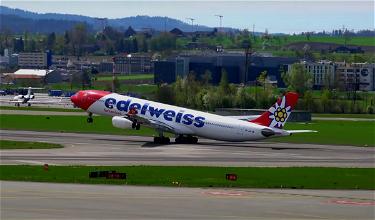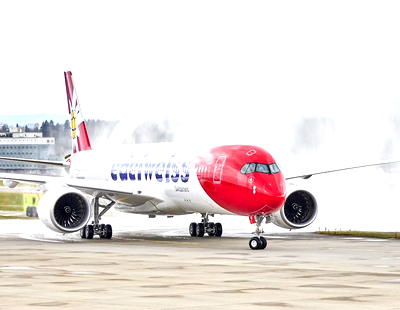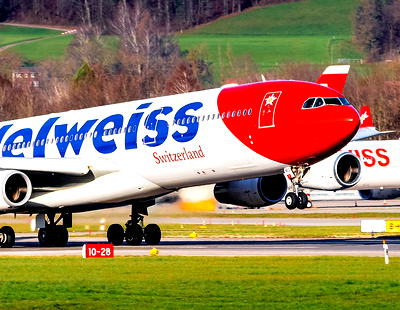An Edelweiss jet had a rather dramatic takeoff from Zurich this weekend, in an incident that’s now reportedly being investigated by the airline.
In this post:
Edelweiss A340 struggles to climb out of Zurich
This incident happened on Saturday, April 6, 2024, and involves Edelweiss flight WK24 from Zurich (ZRH) to Cancun (CUN). For those not familiar, Edelweiss is the leisure subsidiary of SWISS, operating both short and long haul flights to all kinds of holiday destinations.
This particular flight was operated by a 20-year-old Airbus A340-300 with the registration code HB-JMF. The aircraft was taking off from Zurich’s runway 16 at 1:04PM local time. As you can see in the below video, the aircraft rotated for takeoff and became airborne, but then immediately started sinking back toward the runway.
The aircraft seems to get very close to touching down again near the end of the runway, before finally gaining altitude again.
Following this incident, the aircraft managed to gain altitude, and completed a routine flight to Cancun. Since this incident yesterday, the aircraft has operated its return flight to Zurich.
What happened to this Edelweiss A340?
The Aviation Herald reports that the airline is investigating this incident, in what the company refers to as an “unschöner Start” (with “unschöner” meaning something along the lines of unpleasant/not nice). Now, since this seems to be an airline investigation for now (rather than a government safety board investigation), it’s anyone’s guess if the findings end up being released.
The Aviation Herald suggests that a tailwind gust is being suspected as the cause of this. Planes usually take off into a headwind, so a sudden change in the direction of wind could cause the aircraft to lose airspeed, and therefore also lose lift, especially during a critical phase of flight.
There are some other theories out there. Did the plane have enough airspeed when it lifted off? Were the correct takeoff calculations performed based on the weight of the aircraft?
The A340-300 is known for having among the weakest takeoff performance of any heavy jet. There are some planes where you feel like you’re rocketing off during takeoff, while on the A340-300 you can’t help but sometimes wonder if/when the plane is going to lift off. Many joke that the A340-300 relies on the curvature of the earth to get airborne.
Bottom line
An Edelweiss Airbus A340 had a pretty dramatic takeoff from Zurich on Saturday. The jet rotated and became airborne, but then started losing altitude shortly after takeoff. The plane finally gained altitude again just shortly before the end of the runway, in an incident that makes for quite a sight.
What do you make of this Edelweiss A340 incident in Zurich?





i was there and the video was taken by me and uploaded without on twitter without asking for permission
once again !!!!!!! it is rude and for me quite frustrating
zrh aviation channel
I was there and witnessed it - the spotter crowd gave a big ohhhhhhh *expletive* as it rotated. The main gear didn't quite touch the runway surface from my angle and the climb out was reasonably normal. There was little to no wind - it did look more like an over corrected rotation.
I wonder how would the comment section have gone if it was 767 or 777 instead of A340.
Look no further than the headlines of a United 787 hitting turbulence
Probably the plane was loaded with too many gold (or chocolate...) bars....
“ Many joke that the A340-300 relies on the curvature of the earth to get airborne.”
They must be modern day versions of the DC-6. I remember hanging out near the end of the runway in Fairbanks, Alaska watching Everts DC-6 freighters laden with heating fuel bound for bush communities. At times I wasn’t sure if they would clear the hills north of town.
This is not what you want to see with mountains ahead.
That's more of an AvGeek trope, than reality.
It came about from seeing the A340 perform "Flex" takeoffs (essentially: assumed-temperature deration; generally done because the CFM56-5C is expensive as hell to overhaul, relative to the CFM56 derivatives used on the 737 and A320 respectively)...
...which gives the aircraft the appearance of being sluggish and slow to climb.
...That's more of an AvGeek trope, than reality.
It came about from seeing the A340 perform "Flex" takeoffs (essentially: assumed-temperature deration; generally done because the CFM56-5C is expensive as hell to overhaul, relative to the CFM56 derivatives used on the 737 and A320 respectively)...
...which gives the aircraft the appearance of being sluggish and slow to climb.
This isn't a necessity, and the aircraft actually has quite good takeoff performance in TO/GA-- as seen when it'd do transatlantic nonstops to CDG from SXM, off of only 7000ft, with a full passenger load and (some) cargo.
The problem with Flex, as we saw with Emirates in Australia, and several other examples: is that calculations can be flawed, input can be erroneous, and/or the margins can be too thin.
Bad data input + shift in wind, can result in exactly what we saw here, and I'll be surprised if that doesn't turn out to be the outcome.
This airplane performed like the proverbial lead pig. I remember riding up front (the good old days) on an AC 343 coming out of Kansait to YYZ and we didnt rotate until the red runway threshold lights were more than visible. Horrid uneconomical airplane.
It appears to be misconfigured takeoff parameters slats, flaps.
Huh?
Flaps are (clearly) visibly set, and that degree configuration is typical for A330/A340 departures.
To me it looks obvious: wake turbulence. The Zurich-Stockholm Swiss A320 had just taken off from runway 28 crossing the intersection between runways 10/28 and 16/34 only 40 second before the Zurich-Cancun Edelweiss A340 reached the same point while taking off on runway 16. Needless to say, also the video shows that the incident occurs exactly while the A340 is crossing runway 10/28. Case closed.
Thats a good argument! but would wake turbulence from an A320 affect an A340 40 seconds after the A320 left???
This seems plausible but I wonder what the minimums are for spacing between take-off if they are crossing the path, not immediately following, a plane. I am also surprised that they would use perpendicular runways unless there was zero wind, since they do try to take off into the wind. Of course I am assuming runway 28 is making a right-angle cross, but perhaps it is a more angled intersection.
I think the plane did touch down on the runway again, but no smoke came from the tires because the wheels were still spinning. Ben, please correct me if I am wrong. While starting to read this I thought the pilots probably rotated too early.
"There are some planes where you feel like you’re rocketing off during takeoff, while on the A340-300 you can’t help but sometimes wonder if/when the plane is going to lift off."
This is because on a two engine aircraft, if an engine is lost at V1 (takeoff safety speed), the remaining engine has to provide 100% of the power required to continue the takeoff, and also meet second segment of climb requirements. Thus a two...
"There are some planes where you feel like you’re rocketing off during takeoff, while on the A340-300 you can’t help but sometimes wonder if/when the plane is going to lift off."
This is because on a two engine aircraft, if an engine is lost at V1 (takeoff safety speed), the remaining engine has to provide 100% of the power required to continue the takeoff, and also meet second segment of climb requirements. Thus a two engine aircraft must be vastly overpowered when compared to a four engined aircraft, which a loss of an engine at V1, has three remaining engines to provide 100% of the power to meet the same requirements.
I’ve heard a number of A340s takeoff and the engines always sound more strained than other aircraft. Just doesn’t look like it wants to be out there.
Nah, the A340-300 is what I would call 'relaxed' and actually very quiet on take-off. The four lil' hairdryers feel distant and it just sort of gradually wafts up to cruising. It's actually quite a delight to fly on, although I'm sure the pax didn't feel that on this take-off.
For some seconds it looked like it was trying to emulate the vodka burner.
https://www.youtube.com/watch?v=ThoZNxy2JZk
I just flew on a Lufthansa A340-300 from ATL-FRA last week and it felt like it struggled to climb after a very long takeoff roll. I wasn't surprised though. I am an Air traffic controller in the entroute environment. So I know that the A340's with the small hair dryer engines are not great climbers. It is a plane that doesn't perform well under ideal conditions. So if you add in a strong tail wind...
I just flew on a Lufthansa A340-300 from ATL-FRA last week and it felt like it struggled to climb after a very long takeoff roll. I wasn't surprised though. I am an Air traffic controller in the entroute environment. So I know that the A340's with the small hair dryer engines are not great climbers. It is a plane that doesn't perform well under ideal conditions. So if you add in a strong tail wind component or a hot day and pilots have little room for any kind of error when it comes to this aircraft. This video is very scary to watch. Luckily the pilots realized what was happening quickly enough and lowered the angle of attack to try to gain airspeed and get the plane to climb again.
The plane performs fine. Most airlines simply choose to derate the engines for takeoff as it lengthens the time between required engine overhauls. But if the pilot, for safety reasons, chooses to use maximum thrust it will rocket off the runway like a 757.
Reminds me of NW #255 (incorrect flaps) or Pan Am #759 (wind shear), both of which of course had far more tragic outcomes.
I do wonder what that might have felt like in the passenger cabin?